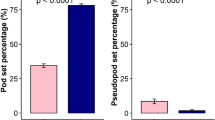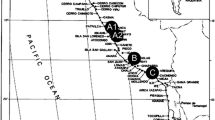Abstract
Inbred lines of white clover (Trifolium repens L.) have been produced utilising the rare self-fertility (Sf) allele. Twenty-two lines of four distinct groups have been maintained through five generations of selfing by single seed descent. Fourteen lines were used in crosses to produce F1s. Both parents and hybrids were analysed for a range of morphological characters. Positive heterosis for dry matter production was observed in half the hybrids. No other trait showed significant heterosis. The degree of heterosis appears to be related to the extent of variation in morphological characters between the parental lines, some combinations of lines yielding heterotic hybrids in all cases, others in none. The majority of the F1 hybrids are superior in terms of dry matter production to eight control varieties.
Similar content being viewed by others
References
Arunachalam, V., A. Bandyopadhyay, S.N. Nigam & R.W. Gibbons, 1984. Heterosis in relation to genetic divergence and specific combining ability in groundnut (Arachis hypogaea L.). Euphytica 33: 33–39.
Atwood, S.S., 1940. Genetics of cross-incompatibility among self-incompatible plants of Trifolium repens. J Am Soc Agron 32: 955–968.
Atwood, S.S., 1941. Controlled self-and cross-pollination of Trifolium repens. J Am Soc Agron 33: 538–545.
Atwood, S.S., 1942a. Oppositional alleles causing cross-incompatibility in Trifolium repens. Genetics 27: 333–338.
Atwood, S.S., 1942b. Genetics of self-compatibility in Trifolium repens. J Am Soc Agron 34: 353–364.
Atwood, S.S., 1942c. Genetics of pseudo-self-compatibility and its relation to cross-incompatibility in Trifolium repens. J Agric Res 64: 699–709.
Bos, I. & P. Caligari, 1995. Selection methods in plant breeding. Plant Breeding Series. Chapman and Hall, London.
Bos, I. & L.D. Sparnaaij, 1993. Component analysis of complex characters in plant breeding. II. The pursuit of heterosis. Euphytica 70: 237–245.
Charcoset, A., M. Lefort-Buson & A. Gallais, 1991. Relationship between heterosis and heterozygosity at marker loci: a theoretical computation. Theor Appl Genet 81: 571–575.
de Vicente, M.C. & S.D. Tanksley, 1993. QTL analysis of transgressive segregation in an interspecific tomato cross. Genetics 134: 585–596.
Diers, B.W., P.B.E. McVetty & T.C. Osborn, 1996. Relationship between heterosis and genetic distance based on restriction fragment length polymorphism markers in oilseed rape (Brassica napus L.). Crop Sci 36: 79–83.
Gibson, P.B. & C.C. Chen, 1973. Success in hybridising and selfing Trifolium repens at different temperatures. Crop Sci 13: 728–730.
Gritton, E.T., 1975. Heterosis and combining ability in a diallel cross of peas. Crop Sci 15: 453–457.
Isleib, T.G. & J.C. Wynne, 1983. Heterosis and testcrosses of 27 exotic peanut cultivars. Crop Sci 23: 832–841.
Jinks, J., 1983. Biometrical genetics of heterosis. In: Frankel (Ed.), Heterosis. Reappraisal of Theory and Practice. Monographs on Theoretical and Applied Genetics 6, pp. 1–46. Springer-Verlag, Berlin.
Johnson, G.F. & W.J. Whittington, 1978. Inheritance of yield components and yield in relation to evidence for heterosis in F1 barley hybrids. Euphytica 27: 587–591.
Kidwell, K.K., E.T. Bingham, D.R. Woodfield & T.C. Osborn, 1994. Relationships among genetic distance, forage yield and heterozygosity in isogenic diploid and tetraploid alfalfa populations. Theor Appl Genet 89: 323–328.
Lefort-Buson, M., B. Guillot-Lemoine & Y. Dattee, 1987. Heterosis and genetic distance in rapeseed (Brassica napus L.) crosses between European and Asiatic selfed lines. Genome 29: 413–418.
Mackey, J., 1976. Genetic and evolutionary principles of heterosis. In: A. Jánossy & F.G.H. Lupton (Eds.), Heterosis in Plant Breeding. Proc 7th Congress Eucarpia: 17–33, pp. 365. Akadémiai Kiadó, Budapest.
Mak, C. & T.C. Yap, 1977. Heterosis and combining ability of seed protein, yield and yield components in long bean. Crop Sci 17: 339–341.
Rotili, P., 1991. The role of selfing in the synthetic and hybrid varieties' constitution in the forage crops. In: Fodder Crops Breeding: Achievements, Novel Strategies and Biotechnology. Proceedings of the 16th Meeting of the Fodder Crops Section of Eucarpia, Wageningen, The Netherlands, 18–22 November 1990.
Sarawat, P., F.L. Stoddart, D.R.S. Marshall & S.M. Ali, 1994. Heterosis for yield and related characters in pea. Euphytica 80: 39–48.
Sparnaaij, I.D. & I. Bos, 1993. Component analysis of complex characters in plant breeding. I. Proposed method for quantifying the relative contribution of individual components to variation of the complex character. Euphytica 70: 225–235.
Stuber, C.W., S.E. Lincoln, D.W. Wolff, T. Helentjaris & E.S. Lander, 1992. Identification of genetic factors contributing to heterosis in a hybrid from two elite maize inbred lines using molecular markers. Genetics 132: 823–839.
Werner, C.P., B.M. Smith, R.M. Godwin & M.J. Kearsey, 1991. The feasibility of producing inbred rather than F1 hybrid cultivars in Brussels sprouts (Brassica oleraceae var. gemmifera): an assessment of recombinant inbred lines. Ann Appl Biol 119: 331–337.
Williams, W., 1954. An emasculation technique for certain species of Trifolium. Agron J 46: 182–184.
Williams, W.M., 1987. Genetics and Breeding in White Clover. In: M.J. Baker & W.M. Williams (Eds), pp. 343–419. CAB International.
Woodfield, D.R. & E.T. Bingham, 1995. Improvement in two-allele autotetraploid populations of alfalfa explained by accumulation of favourable alleles. Crop Sci 35: 988–994.
Xiao, J., J. Li, L. Yuan & S.D. Tanksley, 1995. Dominance is the major genetic basis of heterosis in rice as revealed by QTL analysis using molecular markers. Genetics 140: 745–754.
Yamada, T., H. Fukuoka & T. Wakamatsu, 1989a. Recurrent selection programs for white clover (Trifolium repens L.) using self-compatible plants. I. Selection of self-compatible plants and inheritance of a self-compatibility factor. Euphytica 44: 167–172.
Yamada, T., S. Higuchi & A. Fukuoka, 1989b. Recurrent selection of white clover (Trifolium repens L.) using self-compatible factor, pp. 299–300. Proceedings of the XVI International Grassland Congress, Nice, France.
Author information
Authors and Affiliations
Rights and permissions
About this article
Cite this article
Michaelson-Yeates, T., Marshall, A., Abberton, M. et al. Self-compatibility and heterosis in white clover (Trifolium repens L.). Euphytica 94, 341–348 (1997). https://doi.org/10.1023/A:1002989410326
Issue Date:
DOI: https://doi.org/10.1023/A:1002989410326




